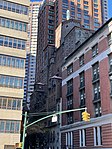1 Lincoln Plaza
Lincoln Square, ManhattanPrivately owned public spacesResidential buildings completed in 1974Residential condominiums in New York CityResidential skyscrapers in Manhattan ... and 2 more
Upper West SideUse mdy dates from August 2019
1 Lincoln Plaza is a mixed-use, commercial and luxury residential condominium building in New York City with 43 floors and 671 units. Construction began in 1971. The building is in the heart of the Lincoln Center neighborhood. Completed and ready for occupancy in 1974, the building is divided into eight floors of commercial space and 36 floors of luxury residential apartments. The roof, which is often considered the 44th Floor is home to the building's private fitness club called Top of the One.
Excerpt from the Wikipedia article 1 Lincoln Plaza (License: CC BY-SA 3.0, Authors).1 Lincoln Plaza
West 64th Street, New York Manhattan
Geographical coordinates (GPS) Address External links Nearby Places Show on map
Geographical coordinates (GPS)
| Latitude | Longitude |
|---|---|
| N 40.77152 ° | E -73.9809 ° |
Address
1 Lincoln Plaza
West 64th Street 1
10023 New York, Manhattan
New York, United States
Open on Google Maps







